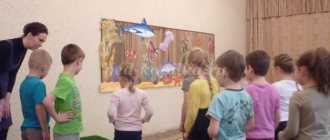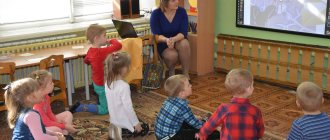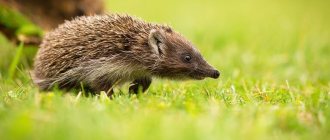Open integrated lesson in the senior group. Works by Marshak
Integrated lesson for children 5-6 years old. Topic: “Journey through the works of S.Ya. Marshak."
The author of the lesson is teacher Vesnina O.V.
Integration of educational areas: Social and communicative development, artistic and aesthetic development. Problem: Today, more than ever, preschool institutions are faced with the problem of developing a child’s interest in books. Modern children are moving away from books, preferring computers and televisions. Goal: To arouse children's interest in the works of S.Ya. Marshak. Objectives: - Summarize children’s knowledge about the writer and his works.
— Continue teaching children to memorize poems and improve their ability to solve riddles. - Develop children's artistic abilities. — Develop emotionally expressive speech. — Develop artistic and creative abilities in productive activities. Progress of the lesson:
Introductory part: (Children enter the beautifully decorated hall. The hall is decorated with children's drawings from the works of S.Ya. Marshak).
Hello guys! I see that you are all so beautiful, you are in a wonderful mood, because it’s so good that we are all gathered here today! Everyone is assembled - children are adults. We can begin. But first we need to say hello to everyone! (we say hello) Main part:
Educator:
Guys, look at our wonderful screen.
Who is shown in the portrait? Children's answer - (S.Ya. Marshak) Educator:
Correct!
This is the great children's writer S.Ya. Marshak. He lived for 77 years, you know his books, your mothers, fathers, and even grandparents knew him. And today I want to invite you on an exciting journey to the land of fairy tales and poems by Marshak. We will wake you up to remember and read the kind, cheerful works of this wonderful writer. And what we will take on this journey, you will have to guess. What kind of miracle? Blue house, Blue windows all around, Wears shoes with rubber And eats gasoline. (bus) (Children guess the riddle, we all get on the bus, the driver is chosen with Marshak’s counting, and everyone goes on a trip to the song “we eat, we eat, we eat”). Station "Vokzal" Educator:
Oh, guys, what's going on there?
What's that noise? (A lady in a hat and with a purse runs in) Robbers, thieves, freaks The dog is the wrong breed......give me back my little dog. Educator: Guys, do you know who this is? Children's answer: (Lady). Educator:
What work is this heroine from?
Children's answer...(Luggage) Educator: Let's remember the first lines of this poem. Children’s answer….(The lady checked in the luggage - a sofa, a suitcase, a travel bag…..etc.). (The Absent-Minded One enters). - “Deeply respected, respected carriage...etc.” Educator:
Look who it is?
And how strangely he is dressed. Children: Instead of a hat on the go, He put on a frying pan Instead of felt boots, gloves He pulled on his heels That's what an absent-minded one is from Basseina Street!!! Educator:
Guys, who is this?
Children: (Abstract). Educator:
We continue our journey.
"Station "Riddle". Educator:
Do you know that S.Ya.
Marshak came up with various riddles for children like you. Let's try to guess them (show slides with riddles). 1 riddle - (glasses).2- (saw). 3- (boots).4- (matches). Do you remember that matches are a very dangerous object? Children...answers. (The numbers 01 appear on the screen) Educator: What are these numbers? Children...answers. Educator:
Every citizen remember the firefighter number... Children - 01.
Educator:
Which work by Marshak are these lines from?
Children - "Fire". Educator:
Fire is our friend, but not always, it can cause trouble!
5-riddle - (calendar). (On the screen is a diagram of times and months of the year). Educator:
S. Ya Marshak has a poem “All Year Round,” remember?
We open the calendar... Children - January begins (name all the months of the year in order) Educator:
Guys, now everyone come to me.
Do you know that every season has its own fairy. And today one of the fairies came to us, but what time of year the fairy is visiting us, we will now guess. (The piece “Spring Fairy” is played; children listen and guess). Educator:
Guys, we need to continue our journey.
Station “Songs and Nursery Rhymes” Educator:
S.Ya.
Marshak lived and studied in England at the University of London and traveled a lot around the country. During these trips, he recorded many different songs and nursery rhymes, but they were all in English. And so that we could read them, Marshak translated them into Russian. Here, for example, is the long-known song “Humpty Dumpty.” Maybe someone wants to tell this song? (Children tell) Educator: - Another song “Little Fairies” (Children tell) Educator:
- And Gleb will help me show the nursery rhyme “Greedy” (we show).
Phys. just a minute. Guys, we all remember the work “Ball”, so we will not only tell you about it, but also show it. My cheerful ringing ball (jumping on two legs) Where did you run off to jump Red, blue, blue (jumping with alternating right and left legs) Can’t keep up with you I clapped you with my palm (claps your hands) You jumped and stomped loudly (we stomp our feet ). (A sparrow can be heard chirping.) Educator:
- Guys, what is that sound?
Children: - it’s a sparrow tweeting. Educator:
- Where did the sparrow have lunch?
Children: - At the zoo with the animals! Educator:
- Do you want to visit the zoo?
Children - Yes Teacher:
- Then let's go!
“Zoo Station” Educator:
Guys, let’s guess who the sparrow had lunch with?
(The voices of wild animals are heard, children listen and guess). Station "Theater" Educator:
- Do you want to go to the theater?
Children: - Yes Teacher:
- Come on in.
(A squeak is heard. Get the mouse toy) Educator: - How small you are, you must have gotten lost, where did you come from? Children: - This is a mouse from the work “The Tale of the Stupid Mouse.” Educator:
- Let's watch this fairy tale.
And our children will show it to us. (screening of the theatrical performance “The Tale of a Stupid Mouse”). Educator:
- Well, guys, our journey is coming to an end, and we need to return to our kindergarten.
(we get on the bus and return) Educator: - Here we are in kindergarten. (knock on the door) Educator:
- Who is knocking on my door with a thick bag on his belt?
Children: - It’s him, it’s him, the Leningrad postman! (The postman brings a book) Educator:
Look what a beautiful book, all the pages are multi-colored!
Children: - This is a Multi-colored book. Educator:
- Yes, exactly, this is a Multi-colored book.
Who is the author of this book? Children: - S.Ya. Marshak Teacher:
- Well done!
Oh, but look, there is not a single illustration in this book, what should I do? Or maybe we can paint it ourselves? (Children's answer). Practical part: (Children color the pages and present the drawings to the guests. Reading poems from the Multi-Colored Book) 1 page (green) This page is green, which means it is permanent summer….i.t. d. page 2 (yellow) Here is the yellow page, Desert Country...etc. d. 3 page (blue) This page is sea, You won’t see land on it...etc. d. 4 page (red) This page is red, Red sun, red summer...etc. d. 5 page (black) This page is at night, The capital is shrouded in darkness... etc. d. 6 page (white) This white page, Here a fox walked along it... etc. Educator :
What a wonderful, bright, colorful book we got, well done!
And now I have a little surprise for you. I want to show you the filmstrip “Baggage” in which you will hear the voice of S.Ya. Marshak. (View). FINAL PART. Educator: My dears, please tell me where we went today? Which writer's works do you remember? Name these works for me? How did the colorful book help? What did you like most? (children's answers). Educator:
Our journey has ended! Let's say goodbye to our guests! All together: GOODBYE.
We recommend watching:
Integrated lesson for children of the senior group Integrated lesson with a presentation for children of the senior group on the topic: Autumn Summary of an open lesson on familiarization with fiction in the senior group. Abstract of an integrated educational activity on cognitive development in a group of senior preschool age on t
Similar articles:
Summary of an integrated lesson in the senior group of kindergarten. Days of the week
Summary of a lesson in the senior group on the topic “Desert”
Abstract of GCD in mathematics in kindergarten in the senior group. Length, height, width of objects
Summary of an integrated lesson on the topic “Animals” in the senior group
Lesson summary - travel for children of the senior group of preschool educational institutions on the topic: Birds
On the topic: methodological developments, presentations and notes
Fascinating drawing using the poking method “Mustachioed Tabby”. Drawing animals in an unconventional way of drawing.
Program content: Learn to draw snowflakes in an unconventional way (with your fingers); learn to convey the mood of a piece of music; develop creativity, independence, imagination.
Through artistic creativity, promote in children a humane attitude towards animals; ability to follow the rules of communication with animals.
Lesson summary on the topic “Mustachioed and Striped” S.Ya.Marshak.
Notes on drawing "Mustachioed Striped" senior group.
notes on drawing "Mustachioed and Striped".
Source
Lesson 8. Repetition of the poem by S. Marshak “The young month is melting”
⇐ PreviousPage 9 of 18Next ⇒
Target. Repeat your favorite poems with your children.
Progress of the lesson
The teacher tells the children that for the New Year they will probably read poems both at home and at Christmas trees.
“I want to listen to your favorite poems. They don’t have to be about Santa Claus, the Christmas tree and the New Year’s holiday,” explains the teacher and listens to 3-4 children from those who are not very active in the classroom.
“Of the New Year’s poems, I love most the poem by Samuil Yakovlevich Marshak, “The Young Moon is Melting,” says the teacher and reads it:
The young month is melting. The stars go out in succession.
The red sun comes out of the open gates.
The sun leads the New Day and the New Year by the hand!
If for any reason the children are unfamiliar with the poem, you should help them remember it.[12]
“At the New Year’s party, you can also read Samuel Marshak’s poem “December,” says the teacher:
In December, in December All the trees are in silver.
Our river, as if in a fairy tale, was paved with frost overnight, renewed skates and sleds, and brought a Christmas tree from the forest.
The Christmas tree cried at first from the warmth of home. In the morning she stopped crying, started breathing, came to life.
Its needles are trembling slightly, the lights are lit on the branches. Like on a ladder, on a Christmas tree, the lights run up.
Firecrackers sparkle with gold. The bravest light that reached the top lit the star with silver.
January
January is a month when holidays come in succession, and then comes the time of infections and colds. If there are fewer children in the group than usual, you can play the new game “Planets Communicate” with them. But first you should introduce them to letters, although some children already know how to read.
The work of researchers indicates that children easily begin to read syllables by memorizing vowel letters. These letters need to be shown to children and helped to remember them. This can be done in a variety of ways. We offer one of them.
In the music room, cards with vowel letters are placed in alphabetical order: A, E, I, O, U, Y, E, Yu, Ya (E is omitted deliberately).
“These are vowel letters, they can be sung,” explains the teacher. “You will now see this by singing them after Olga Ivanovna” (music worker).
“Ah,” the musician sings, followed by the children (the teacher points to the letter), “E...”
Next, the letters are transferred to the group, and the teacher helps the children remember them.
Having laid out the letters on different words, the teacher instructs several children to find certain letters: “Olya finds the letter I
", Sasha - the letter
Y
, Yura - the letter
U
, Anton - the letter
I.
"
The rest of the children check whether the task was completed correctly.
A few days later, the teacher invites 5-6 children to play the game “The Planets Communicate.” Children and the teacher sit at double tables. They have cards divided into two parts. On the right side of the card are written 4-6 vowels, on the left is the first letter of the player’s name. A child draws it.
For example:
…
With AIUO
IN IOEJUE
M AUOYAYU
The teacher informs the players that they are now inhabitants of different planets: V - Venus, M - Mars, C - Saturn. (If a planet is unknown, starting, for example, with the letter A
, we have to invent it.)
Next, there is a radio call between the radio operators of the planets. Helping to set up the game, the teacher takes on the role of a translator.
“Planet Saturn, you are on the air. Which planet do you have a question for?” – the translator is interested.
The child pronounces the syllables: sa - si - su
etc.
"Attention! - says the translator. “A radio operator from the planet Saturn asks a colleague from the planet Venus to answer what time of year it is now (what is the weather like, did they celebrate the New Year on Venus, is there a sea on Venus...).”
The radio operator from Venus reads his syllables and can answer the question himself.
For individual work with children at home, parents should recommend the workbooks “Literacy Lessons for Preschoolers: School Preparatory Group” (M.: Mozaika-Sintez).
Parents can also use “The Lion Cub and the Turtle Primer” by S. Kozlov. In the book, an inquisitive and curious lion cub persistently studies letters, infecting almost all animals who want to become literate.
Children should be encouraged to play printed board games. Preschoolers can play independently, but control on the part of the teacher is very important, since players do not always have enough endurance and patience.
In the first half of January, it is advisable to read to children the program stories of N. Nosov and chapters from the book “The Adventures of Dunno and His Friends,” as well as the story of S. Georgiev “I Saved Santa Claus.”
Children should continue to be introduced to illustrated books of poetry and fairy tales, in particular “Winter Poems”[13]. It is advisable to compare the winter landscapes of the artist V. Belousov with the fabulous winter of Yu. Vasnetsov[14]. You can also introduce children to the drawings of I. Bilibin.[15]
Lesson 1. New Year's meetings
Target. Improve children's ability to write stories from personal experience. Activate the speech of preschoolers.
Progress of the lesson
“The New Year holidays have passed, the most beautiful and cheerful days of January,” the teacher begins the conversation. – Someone met with Santa Claus, someone went to visit, someone traveled with their parents, and everyone, naturally, received gifts. Tell us where you were, what you saw, what you especially remember. And I will help you, if necessary, to make your stories literate and interesting.”
The teacher listens to the children's stories and asks clarifying questions. If the first two stories are about visiting the Christmas tree, you should ask the children if any of them were in the theater and if so, at what performance; who went on vacation with their parents; who received guests, etc.
In conclusion, the teacher asks the children a riddle, hinting that everyone was waiting for this hour on New Year’s Eve:
How many times will the clock strike if the mustache is moved? (Twelve)
The teacher helps the children remember the riddle and invites their parents to guess it.
⇐ Previous9Next ⇒
Recommended pages:
Use the site search:
Drawing in the senior group “Colored Pages” according to S. Ya. Marshak
Ovchinnikova Marina Sergeevna
Drawing in the senior group “Colored Pages” according to S. Ya. Marshak
Drawing in the senior group on the topic “ Colored Pages ” by S. Ya. Marshak .
Goal: to expand children's knowledge about the work of the poet and writer S. Ya. Marshak , to consolidate the techniques of painting with watercolors .
Objectives: to teach children to conceive the content of their drawing in a certain color scheme and to maintain this condition to the end. Strengthen children's knowledge about colors and shades . Develop imagination and creativity. To cultivate a sense of beauty, to see the beauty of the created image.
Material and equipment. Pictures of colored pages of a book by S. J. Marshak “ The Multi-Colored Book ”
, sheets of white A4 paper, watercolors, gouache, brushes, oilcloths, sippy cups, palettes.


